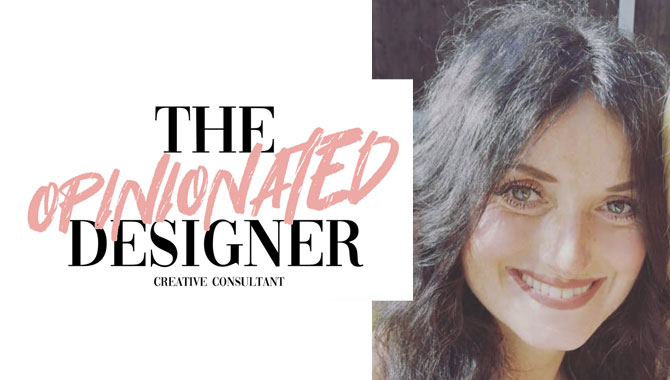—-
To stay in the loop with the latest features, news and interviews from the creative community around licensing, sign up to our weekly newsletter here

We caught up with Emma to find out more about her approach to design – and why she feels the fashion industry’s perception of the licensing space is changing.
Emma Horton has been working in the fashion industry for close to 20 years, and now runs her own creative consultancy, The Opinionated Designer.
We caught up with Emma to find out more about her approach to design – and why she feels the fashion industry is changing its perception of the licensing space.
Emma! Thanks for making time. Let’s kick off with an easy one: How did you get started working with brands?
I fell into it! I trained as a lingerie designer and worked with the likes of M&S. From there, I moved onto the Ann Summers-style lingerie and that sparked my interest in catwalks. I then moved into fast-fashion and was designing for firms like ASOS, River Island and Miss Selfridge.
Around that time, a lot of my friends moved to London and I wanted to as well, and fortunately one of my friends got me an interview with Disney and I got the job. So that spun me out of fast-fashion and into licensing.
What were you doing at Disney?
I was a DTR designer. I started off working on Tesco DTR and then moved to George DTR and helped out on Primark too. I knew someone from Fashion Lab – now Global Brands Group – and moved there from Disney. I eventually headed up the fast-fashion team there and then led the UK design team, and then the EU design team. While there I worked on some halo collaborations with the Primark team, like The Simpsons menswear collection and a Barbie ladies range.
Yes, I remember that Simpsons range. It looked great!
We were tight on time with that one! And approvals take some time with that brand. It was a challenge, and we didn’t think we’d get there at one point! That said, when it all came together it looked really great.

Absolutely. Now you’re a creative consultant under the Opinionated Designer name. What prompted the move to launch something on your own?
I was approached by Yaman Tekstil to be their creative director, so that’s who I’m doing a lot of work for at the moment. It was a fantastic opportunity. They’re a new licensee for the UK, and have an exclusive to the MGA brand, LOL OMG. It’s strange because I’ve gone from overseeing 20 designers, but not actually doing design work myself, and now I’m back to designing. Over lockdown, it was a bit daunting to go self-employed, but it’s been fantastic.
What are your first few steps creatively when designing a licensed fashion collection?
I’ll use LOL OMG as an example. From the conversations I had with MGA, it was about establishing the right age group and then looking at other designer brands that operate in that space. I love places like Childrensalon where you have everything from Moschino to your mid-range brands. It’s a fantastic resource for inspiration.
I pull out trends that I feel strongly about. I do use WGSN but I don’t like to stick to it too closely because that’s what everybody works to. Whenever I speak to retailers, they’ll always say ‘we don’t want you to force it into a trend’. The licence has to work on its own terms. I’ll also sometimes get a style guide from a licensor and strip that back to some key trends and key colours.
Is there any key things designers can do when working on a licensed range to help bolster its chance of success?
You can’t just start designing straight away. You have to understand the brand and who they’re targeting. Look at past collections and see what’s worked and what hasn’t.
“Before, some buying teams would have their main range – and licences were a bit of an afterthought. These days, people are looking at them as being far more hand-in-hand.”
Look at a brand like The Simpsons. Could you have something inspired by the colours of Marge Simpson, rather than just a graphic of the character? Bobby Abley does some incredibly smart work with brands that doesn’t go in the usual directions.
Different briefs require different thinking. Some will be edgy, and you can play around, while others will have a defined customer base and they’ll know what works for them. It’s a real case-by-case basis.
I also think it’s key for licensees to keep licensors in the loop with designs as early as possible. Lots of people take things out of style guides, blow them up, put it on a t-shirt and that’s that – and I should add, there’s a time and a place for that for sure – but licensees should try and push things with their licensors. That’s how you innovate.
Is the world of licensed fashion in a good place at the moment?
Well, I’ve always felt that, for some buying teams, they have their main range – and then licences are just an afterthought. These days, I feel like people are now looking at them as being hand-in-hand. Fashion brands now see the potential of working with licences, whereas some were a little bit snobby towards it in the past. It’s cool now. Look at Primark; brand collaborations are now one of the biggest parts of their business.
Before I let you go, how do you fuel your creativity?
I love catwalks. I’m constantly researching catwalks and I’m always learning too. New skills, new software – especially as digital catwalks become more of a thing, it’s useful to have that capability. But yes, looking at catwalks really inspires me and pushes my creativity forward.
Brill – huge thanks again Emma.
Enter your details to receive Brands Untapped updates & news.